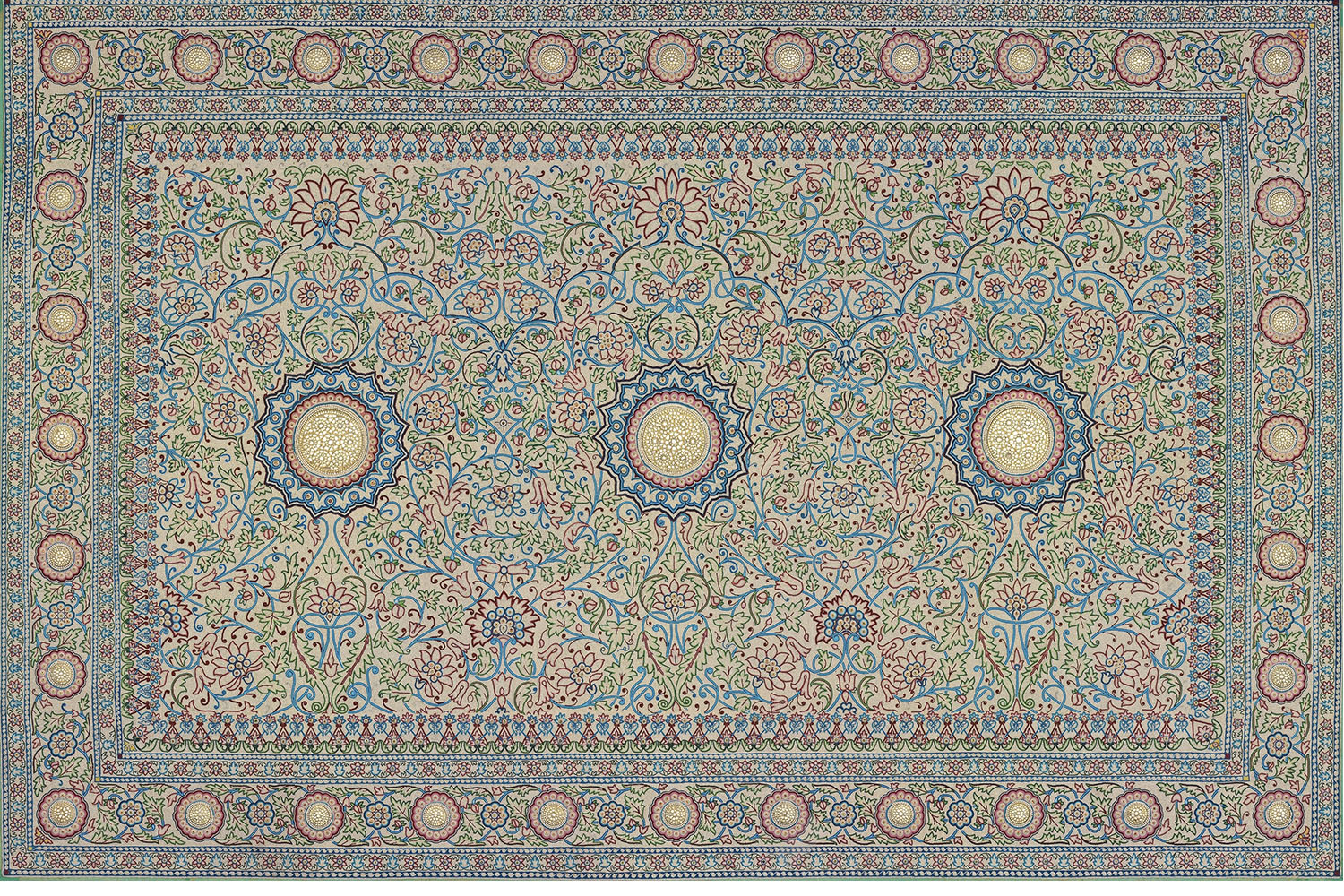ARTICLE
Pearl Carpet of Baroda
An exceptionally rich piece of tapestry, the bejewelled carpet popularly known as the Pearl Carpet of Baroda, or simply the Baroda Carpet, was commissioned by the Maharaja of Baroda Khande Rao II Gaekwad (r. 1856–1870) in 1865. Densely embroidered with pearls and other gems, it was intended as a gift to adorn the tomb of Prophet Mohammed in Medina, in present-day Saudi Arabia, but remained in India as Khande Rao died before it could be sent. Made over the course of nearly five years by artisans previously employed by the Mughal courts, the carpet exemplifies the sophistication of traditional Indian craftsmanship, the wealth of regional rulers and the lavish patronage they endowed on the arts.
Approximately 2.64 metres long and 1.74 metres wide, the carpet comprises a base of deer skin and silk that is heavily embroidered with beads and precious stones forming arabesque patterns and motifs. It is estimated to contain over 1.5 million Basra pearls altogether weighing about 30,000 carats, and cut-diamonds weighing close to 400 carats. In addition, rubies, emeralds, sapphires and coloured glass beads embellish parts of the composition. The central field features three large roundels in a row, each consisting of an innermost circle of seven bright, round floral motifs made of diamonds set in gold and silver, surrounded by a rim of pink and gold petals, and an outermost ring of blue and white pointed petals. The rest of the central field is covered by entwined vines and other floral motifs, including five prominent palmettes, three of which top the arches over the roundels. The central field is bounded by a deep border featuring thirty-two smaller roundels encrusted with emeralds and blue and red sapphires, imitating the inner and middle levels of the central roundel design. These are surrounded by a pattern of vines, buds and round floral motifs.
The high quality natural marine pearls used for the carpet — most between one and three millimetres in diameter, with some measuring up to four millimetres — were sourced from the southern part of the Arabian Gulf (present-day Qatar and Bahrain). Pearl harvesting had been a traditional occupation for centuries along this coast, and became a mainstay of the region’s economy with the pearls sold to buyers from Asia and Europe via the port of Basra in present-day Iraq. India was the biggest purchaser of these pearls, with its appetite for precious jewels among the aristocracy and royalty: in the late nineteenth century, Basra pearls constituted most of the pearls being used in India.
With the decline of the Mughal empire and the establishment of British colonial rule in the subcontinent, artisans of the Mughal court had to move to smaller regional courts in search of income and patronage for their work. The princely state of Baroda was a renowned and flourishing cultural centre, and its royal court received many of these expert craftspersons, amongst whom were weavers, gem-cutters and jewellers. While Baroda had a rich existing tradition of embroidery and brocade-work, these artisans brought with them their own distinctive style and the influence of their older patrons. The design of the pearl carpet is believed to have been inspired by the shroud commissioned by Shah Jahan for the tomb of Mumtaz Mahal in the Taj Mahal, Agra. Although he was a Hindu, Khande Rao’s intention to donate the carpet to the mosque in Medina was likely an aspirational gesture in keeping with the Mughal tradition of sending lavish donations to Mecca and Medina — the twin holy cities of Islam — in an attempt to connect his patronage to the legacy of the powerful Mughal emperors who preceded him.
Early twentieth-century accounts suggest that the carpet was originally part of a five-piece tapestry set that may have formed a canopy structure. However, further information on the other parts or their whereabouts has been scarce.
After Khande Rao’s death, the carpet was inherited by his successors, who initially chose to retain it within the royal treasury. It made its first public appearance during the Indian Art Exhibition in Delhi in 1902–03 and its second in 1985–86 as part of the India! exhibition at the Metropolitan Museum of Art, New York. Khande Rao’s granddaughter-in-law the Maharani of Baroda Sita Devi became the carpet’s custodian from the mid-1940s until 1988. She moved it out of the country after she took up residence in Monaco with her husband the Maharaja of Baroda Pratap Singh Rao Gaekwad after 1946, and is believed to have sold it later to alleviate her financial difficulties.
While the movement and provenance of the carpet in the decades after it left India is unclear, it surfaced in 2009 at the first Sotheby’s Arts of the Islamic World auction in Doha, Qatar, where it sold for approximately 5.5 million USD. At present, the carpet is exhibited at the National Museum of Qatar in Doha.
Bibliography
Google Arts and Culture. “The Pearl Carpet of Baroda.” Accessed March 24, 2023. https://artsandculture.google.com/asset/the-pearl-carpet-of-baroda-unkown/XAFJi_2A3hbKsA?hl=en.
Sotheby’s. “Lot 401: The Pearl Carpet of Baroda.” Auctions. Accessed March 24, 2023. https://www.sothebys.com/en/auctions/ecatalogue/2009/the-pearl-carpet-of-baroda-d09005/lot.401.html?locale=en.
Welch, Stuart Cary. India: Art and Culture 1300–1900. New York: The Metropolitan Museum of Art, 1985.
Zeidan, Loubna. “Collection Highlight: The Baroda Carpet.” Qatar Museums. January 11, 2022. Accessed March 24 2023. https://qm.org.qa/en/stories/all-stories/baroda-carpet/.







